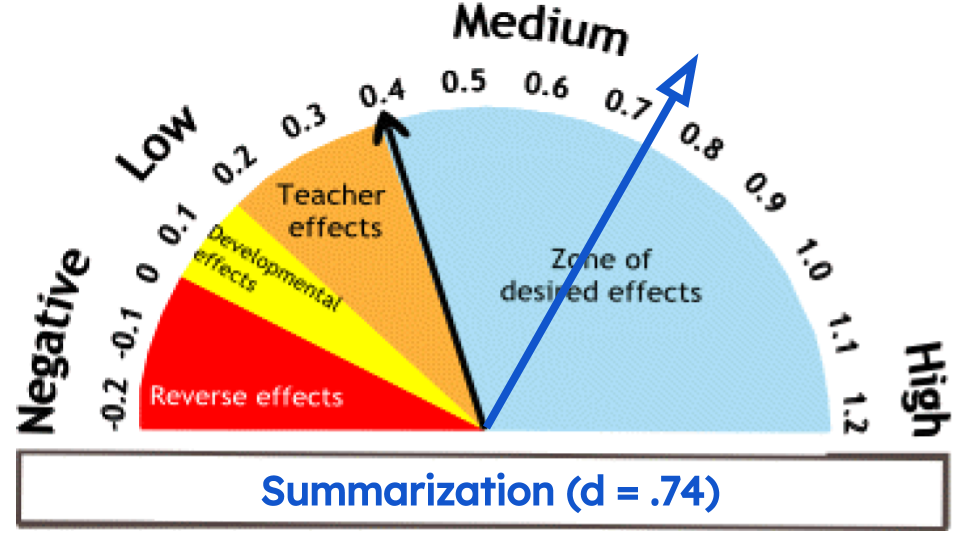In “Virtual Learning Strategy #1: Classroom Discussion,” I highlighted a popular strategy for virtual teachers. Yet classroom discussion does not reign supreme. It is not the sole high-effect size instructional strategy teachers are relying on. In this blog entry, we’ll explore another strategy that has garnered attention for your distant learners.
Weston Kieschnick’s Blended Approach
In his approachable book, BOLD Schools, author Weston Kieschnick (@Wes_Kieschnick) lays out a simple plan that blends a high-effect size strategy with a digital tool. He emphasizes that adding too many tools or strategies can be confusing. Worse, it may have the opposite effect than what you intend, which is, as John Hattie puts it, to speed up student growth in one year.
Let’s explore some of the strategies and digital tools educators are using. Here’s a hint which strategy we’ll be focusing on:

Strategy #2: Summarization
The second most oft-mentioned strategy is summarization. I have adapted the description below from the Corwin Visible Learning Meta X database:
The ability to summarize a text is often taken as a marker of reading comprehension. For this reason, many scholars have advocated explicit summarization training. For students who struggle with comprehension, explicit summarization training is a recommended.
Summarization isn’t only about finding what’s worth keeping. It can also be about deleting unnecessary material, or material that is redundant.
The act of summarizing can involve substituting a subordinate term for a list of items. It can also have students selecting a topic sentence. Students may construct a topic sentence if one is only suggested in a text.
Summarization enjoys an effect size of 0.74, the same as reciprocal teaching. This makes it a powerful tool for teachers and even more powerful as a self-regulation strategy for students. Summarization allows students to control their own learning.
In a similar way, teachers can scaffold student metacognition. They need to reflect on their own work. Weston suggests asking practical questions, such as:
- Which specific strategy will you leverage to meet goals?
- What will you as the teacher be doing?
- What will students be doing?
This boils down to a question Diane Sweeney poses: “What instructional practices will help students reach the goal?” Let’s take a stab at responding to these questions. Summarization is the second high-effect size strategy in use to meet academic goals.
Summarization for Virtual Learning
Summarization, a surface learning strategy, works great for introducing students to new learning and plays well with virtua learning tools such as Flipgrid. Here’s what teachers are saying about this digital tool:
- “I plan on using FlipGrid. Students submit timed audio submissions of them synthesizing the info.”
- “Students need a lot of practice with summary. I use summary and Flipgrid to empower students. Students can create a summary of a text. Then they critique the summaries of others to determine who had the best summary. It also gives students the benefit of hearing the information several times as well.”
Other resources that have drawn the attention of teachers include KAMI and Buncee. In this example, you can see that selecting text is one way to summarize.
“The HESIS I will use is Summarizing. I will use KAMI to present a text as it allows students to highlight key terms. I will have students share the key terms they highlighted. Then, they will discuss why they selected the terms they chose. As a continuation, students share their summaries aloud.
“I could use summarization. Then, I would ask students to use Buncee. They would use it to share their thoughts and notes over the topic,” says another teacher. As you may have noted in each of these responses, there is something missing. Teachers assumed, or chose not to state, what they would be doing.
Let’s revisit Weston’s questions:
- Which specific strategy will you leverage to meet goals? Summarization is the strategy teachers above chose.
- What will you as the teacher be doing? We’re not sure what the teacher will be doing to introduce summarization practices. This is something that they could clarify.
- What will students be doing? Students will summarize or highlight content then share what they have done. Technology tools like Flipgrid, KAMI, Buncee play a key role.
Before we leave these questions, take a moment to reflect on these questions from a teacher and/or coach perspective.
In Their Shoes
How would you, as a teacher, clarify one of the teacher activities above? What instructional practices would you, as a coach, encourage teachers to use? Coaches, be sure to check out Diane Sweeney’s free ebook, Moves for Virtual Coaching.
Did You Know?
Get an introduction to core learning, high-effect size instructional strategies. Do that via TCEA’s Strategies That Work, Part 1: Core Components self-paced course. Take the mystery out of teaching and learning strategies. Available online now and get a year of access to content.
Other Digital Tools to Pair with Summarization
In Matching HES Strategies and Digital Tools, find other ed tech tools to pair with summarization. Here’s a quick list:
Digital Annotation Tools
Highlight the Relevant/Irrelevant
Summarization works as a powerful, surface learning strategy. Combine it with a digital tool to move beyond paper and pencil activities and end up with greater engagement and retention.

